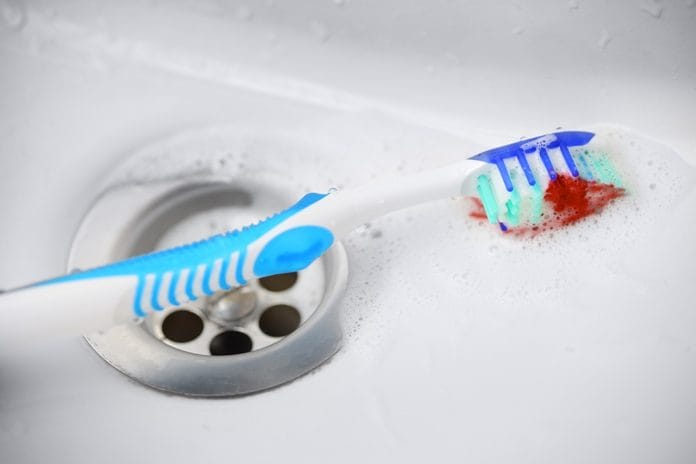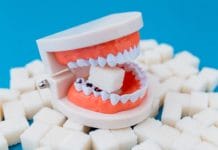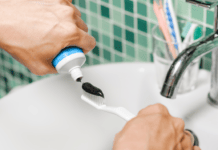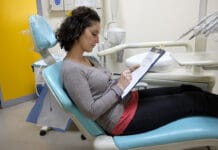The American Academy of Periodontology defines periodontitis (periodontal disease) as “Inflammation of the periodontal tissues resulting in clinical attachment loss, alveolar bone loss, and periodontal pocketing.”1
The disease is the leading cause of tooth loss in the United States. It is estimated that 47% of people older than age 30 have some form of periodontal disease, and this is even greater at 70% for people 65 years and older.2
Bacterial biofilm is still considered to be the “cause” of periodontal disease, but there are many other factors such as the Epstein-Barr virus, herpesviruses, and systemic conditions that cause immunosuppression contributing to the disease as well.3
Out with the Old, in with the New
In 2017, both the American Academy of Periodontology (AAP) and the European Federation of Periodontology at the World Workshop updated the 1999 guidelines and classifications for diagnosing periodontal disease and developed new classifications for peri-implant diseases. These new guidelines help clinicians provide a more specific and detailed periodontal diagnosis and take new information into consideration, such as systemic diseases, patient-specific risk factors, and expected prognosis.4
Outlined below is a brief description of these new classifications, as seen in an article published in the Journal of Periodontology. The article’s focus was to summarize the information discussed at the World Workshop.4
Periodontal health, Gingival Diseases, and Conditions
- Periodontal health and gingival health
- Clinical gingival health on an intact periodontium
- Clinical gingival health on a reduced periodontium
- Stable periodontitis patient
- Non-periodontitis patient
- Gingivitis: biofilm-induced
- Associated with dental biofilm alone
- Systemic or local risk factors
- Drug-influenced gingival enlargement
- Gingival disease: non-biofilm induced
- Genetic/developmental disorders
- Specific infections
- Inflammatory and immune disorders
- Reactive processes
- Neoplasms
- Endocrine, nutritional, and metabolic disorders
- Traumatic lesions
- Gingival pigmentation
Types of Periodontal Disease
- Necrotizing periodontal diseases
- Necrotizing gingivitis
- Necrotizing periodontitis
- Necrotizing stomatitis
- Periodontitis as a manifestation of systemic diseases
- Periodontitis
- Stages I-IV
- Stage I: Initial periodontitis
- Stage II: Moderate periodontitis
- Stage III: Severe periodontitis with the potential for additional tooth loss
- Stage IV: Severe periodontitis with the potential for loss of dentition
- Stages I-IV
-
- Extent and distribution: Localized (less than 30% of teeth), generalized (greater than 30% of teeth), incisor-molar distribution
- Grades/risk of progression
- Grade A: Slow rate of progression
- Grade B: Moderate rate of progression
- Grade C: Rapid rate of progression
Periodontal Manifestations of Systemic Diseases and Developmental and Acquired Conditions
- Systemic diseases/conditions that affect the periodontal supporting tissues
- Other periodontal conditions
- Periodontal abscess
- Endodontic-periodontal lesions
- Mucogingival deformities and conditions around teeth
- Gingival phenotype
- Gingival recession
- Lack of gingiva
- Decreased vestibular depth
- Frenum/muscle attachment
- Gingival access
- Abnormal color
- Condition of the exposed root surface.
- Traumatic occlusal forces
- Primary occlusal trauma
- Secondary occlusal trauma
- Orthodontic forces
- Prostheses and tooth-related factors
- Localized tooth factors
- Dental prostheses
Peri-implant Diseases and Conditions
- Peri-implant health
- Peri-implant mucositis
- Peri-implantitis
- Peri-implant hard and soft tissue deficiencies
Educating our patients
Educating our patients that gingivitis (specifically biofilm-induced) is reversible (and periodontitis is not) is crucial to getting them to understand the severity of their disease. I like to compare periodontal disease to type 2 diabetes with my patients. Once you have the disease, it can only be maintained, not cured, and it will be a lifelong battle.
At the 2017 World Workshop, where the new periodontal guidelines and classifications were laid out, it was stated that “a patient with gingivitis can revert to a state of health, but a periodontitis patient remains a periodontitis patient for life, even following successful therapy, and requires life‐long supportive care to prevent recurrence of disease.”4
In the case of implants, peri-implant mucositis is the equivalent of gingivitis in natural teeth. It can lead to peri-implantitis, which is the equivalent of periodontal disease in their natural teeth counterparts. Peri-implantitis can occur rapidly and lead to the loss of the implant.4
Diagnosing Periodontal Disease
Early diagnosis is key. Just like many other diseases, the earlier it is found and treated, the better the prognosis is.5
The AAP states that clinical attachment loss (CAL) should be used to initially stage periodontal disease, but, if not available, then radiographic bone loss can be used in its place.
See this chart from the AAP on staging and grading of periodontal disease.6
Treating Periodontal Disease: Non-surgical and surgical
Non-surgical periodontal therapy is still considered the gold standard to address periodontitis. The AAP advises that periodontal disease should always be treated in the “least invasive and most cost-effective manner.”7 Dental hygienists understand that scaling removes biofilm and calculus from teeth and root surfaces. This does not mean obtaining glassy smooth root surface cementum, but just enough so that the bacterial toxins are effectively removed.7 Explaining to patients the technicality of non-surgical periodontal therapy and how it differs from a prophy may help them accept recommended treatment.
The clinician can use many adjunctive tools in addition to debridement. Some adjunctive therapies include laser bacterial reduction, air polishing, and medicaments. It is important to note that there are moderate risks to the use of these therapies, and the risks should be weighed against the benefits for the patient.8
Another article released by the Journal of Periodontology focused on supra and subgingival irrigation in treating periodontal disease. The authors stated, “There are limited data to indicate that a single episode of subgingival irrigation provided by the therapist will enhance the efficacy of root planing.”9
Chlorhexidine (CHX) has been used in dentistry for a long time and is a great choice as an antiseptic rinse for some patients. Research, however, has shown that CHX inhibits periodontal regeneration by preventing fibroblasts from attaching to the root surface of teeth. These studies have also shown that CHX has cytotoxic effects on the following: “gingival epithelial cells, periodontal ligament cells, cultured alveolar bone cells, and on osteoblastic cells.”10 Povidone-iodine has also been shown to inhibit fibroblast cells similar to CHX. However, it should be noted that these studies were done in vitro not in vivo; meaning in a lab setting outside of a living organism, not in a human mouth.
In states where dental hygienists are permitted to administer local anesthetic, the choice to anesthetize and by what method is routinely determined by the hygienist’ discretion, but there is evidence to support that the decrease in probe depths is greater in non-surgical periodontal therapy cases that have utilized local anesthetic.11
The use of lasers in dentistry continues to be a hot topic and can even be described as controversial. The American Academy of Periodontology states, “At this time, there is insufficient evidence to suggest that any specific laser wavelength is superior to the traditional treatment methods of the common periodontal diseases, such as periodontitis.”12
In an article published in JADA, the authors advise against the use of both the Nd:YAG and non-PDT diode lasers for treatment in periodontal disease. They go on to state that there may be some benefit from the use of a PDT diode laser, but that the risks do not outweigh the potential benefit, and their recommendation for use in treating periodontal disease is considered “weak.”8
In our periodontal practice, every non-surgical periodontal therapy patient has a re-evaluation after treatment has been completed, and it is at this appointment that we review the results of the initial treatment with the patient and discuss periodontal maintenance recall intervals and any surgical treatment recommendations.
Surgical
Osseous surgery (also known as flap surgery or pocket reduction surgery) entails the periodontist making incisions in the gingiva and flapping the gingiva back so they can see the roots of teeth and surrounding bone. More thorough root planing and bacterial removal can be completed at this point, and defects within the bone that have been caused by periodontal disease can be smoothed and corrected so that bacteria is less likely to stick to these surfaces in the future.
The gingiva is usually positioned more apically than they once were, which allows the patients better access to clean the teeth.1,2 One of my former doctors compared the bone surrounding the teeth to a road and the craters and deformities within the bone from the periodontal bacteria to potholes. She would tell the patient that she was “filling in” and “smoothing” the potholes so that bacteria couldn’t collect in them and cause further destruction.
Bone grafting and bone and tissue regeneration products may be used in conjunction with periodontal surgery. Bone grafting materials can include autografts, synthetic, and donors (both human and animal); it can be in particle form that is packed into the bony defects and the surrounding bone as well as a flowable material. Many times, the grafting materials stimulate the patients’ body to regenerate their own bone to regrow.2
Guided tissue regeneration is yet another type of bone grafting process where a synthetic piece of material is placed between the bone and gum tissue and prevents tissue from inhibiting the site so that only bone can regrow in the area.1,2,13,14,
Hygienists should be aware there are different healing times for periodontal surgeries and bone grafting procedures because periodontal probing may need to be delayed until the areas have completely healed.
Helping Patients Fight Their Disease
Once a patient has had any periodontal treatment (non-surgical, surgical, or a combination of both), they will require periodontal maintenance recalls at more frequent intervals in order to try to maintain their disease and try to prevent recurrence.4,15 According to a paper released by the Journal of Periodontology, their research states, “Although pocket debridement suppresses components of the subgingival microflora associated with periodontitis, periodontal pathogens may return to baseline levels within days or months. The return of pathogens to pretreatment levels generally occurs in approximately 9 to 11 weeks but can vary dramatically among patients.”16
This evidence should be taken into consideration when determining the maintenance recall intervals for our periodontal patients. Explaining this to patients is crucial so that they understand why we are recommending more frequent recalls than what they’ve been accustomed to.
In our periodontal practice, these recalls typically alternate between their general dentist and our office to ensure the patient is getting adequate continuity of care. Due to the waxing and waning nature of periodontal disease and its ability to be very destructive in a short amount of time, a periodontal maintenance recall should include full-mouth probing at every visit regardless of the time interval and radiographs when indicated.
It’s important to stress to these patients that their disease makes them more susceptible to infection and tooth loss. They have to be so diligent with their homecare and maintain periodontal maintenance recalls. If they have systemic risk factors such as diabetes, we should be educating them on how some of these can have a bi-directional relationship on their periodontal disease and affect their treatment outcomes.
Before you leave, check out the Today’s RDH self-study CE courses. All courses are peer-reviewed and non-sponsored to focus solely on high-quality education. Click here now.
Listen to the Today’s RDH Dental Hygiene Podcast Below:
References
- Periodontitis. American Academy of Periodontology. 2019. Retrieved from https://members.perio.org/libraries/glossary/entry?GlossaryKey=d93c420e-932-4bdd-b01c-d545af310a5b&tab=groupdetails.
- Periodontal Disease. Centers for Disease Control and Prevention. 2013. Retrieved from https://www.cdc.gov/oralhealth/conditions/periodontal-disease.html.
- Teles, R., Teles, F., Frias-Lopez, J., Paster, B., Haffajee, A. Lessons learned and unlearned in periodontal microbiology. Periodontol 2000. 2013; 62(1): 95–162. Retrieved from https://www.ncbi.nlm.nih.gov/pmc/articles/PMC3912758/.
- Armitage, G., Berglundh, T., Caton, J.G., Chapple, I.L.C., Jepsen, S., Kornman, K.S., Mealey, B.L., Papapanou, P.N., Sanz, M., Tonetti, MS. A new classification scheme for periodontal and peri‐implant diseases and conditions – Introduction and key changes from the 1999 classification. Journal of Periodontology. 2018; 89(S1): 1-8. Retrieved from https://aap.onlinelibrary.wiley.com/doi/10.1002/JPER.18-0157.
- Bhowmik, E., Deepika, PCR, Priya, DC.Various Treatment Modalities in Aggressive Periodontitis. Contemp Clin Dent. 2019; 10(4): 672–675. Retrieved from https://www.ncbi.nlm.nih.gov/pmc/articles/PMC7390414/.
- Greenwell, H., Kornman, K.S., Maurizio, S.T. Staging and grading of periodontitis: Framework and proposal of a new classification and case definition. J Periodontol. 2018; (89): 159-172. Retrieved from https://pubmed.ncbi.nlm.nih.gov/29926952/.
- Non-surgical Periodontal Treatment. American Academy of Periodontology. 2019. Retrieved from https://www.perio.org/consumer/non-surgical-periodontal-treatment.
- Abt, E., Cobb, C.M., Estrich, C., Frantsve-Hawley J., Forrest, J.L., Greenwell, H., Gunsolley, J., Hanson, N., Harrel, S.K., Hujoel, P.P. ,John, M.T., Michaloqicz, B.S., Noraian, K.W., Rossmann, J., Smiley, C.J., Tracy, S.L. Evidence-based clinical practice guideline on the non-surgical treatment of chronic periodontitis by means of scaling and root planing with or without adjuncts. JADA. 2015; 146(7): 525-535. Retrieved from https://jada.ada.org/article/S0002-8177(15)00334-7/fulltext
- Greenstein, G. Position paper: The role of supra- and subgingival irrigation in the treatment of periodontal diseases. J Periodontol. 2005; 76(11): 2015-2027. Retrieved from https://pubmed.ncbi.nlm.nih.gov/16274324/.
- Jankin, J., Skrzypczak-Jankun, E., Kotwicka, M., Nowak, A., Wyganowska-Swiatkowska, M., Urbaniak, P. Clinical implications of the growth-suppressive effects of chlorhexidine at low and high concentrations on human gingival fibroblasts and changes in morphology. International Journal of Molecular Medicine. 2016; 37(6): 1594-1600. Retrieved from https://www.spandidos-publications.com/10.3892/ijmm.2016.2550
- Dong, S., Huan-Xin, M., Jian, J., Rui-Fang, L., Shu-Wen, S., Song Y., Zhang, L., Zhan-Qiang, C. Influence of local anesthesia on the outcomes of non-surgical periodontal treatment. Chin Med J (Engl). 2020; 133(16): 1908–1914.Retrieved from https://pubmed.ncbi.nlm.nih.gov/32826453/
- Laser Treatment for Gum Disease. American Academy of Periodontology. 2019. Retrieved from https://www.perio.org/consumer/gum-disease-laser-therapy.
- Periodontal (Gum) Disease: Causes, Symptoms, and Treatments. National Institute of Dental and Craniofacial Research. 2013; (13):1142. Retrieved from https://www.nidcr.nih.gov/sites/default/files/2017-09/periodontal-disease_0.pdf.
- Periodontitis. MayoClinic. 1998-2020. Retrieved from https://www.mayoclinic.org/diseases-conditions/periodontitis/diagnosis-treatment/drc-20354479.
- Sanchez, A.M. D4910: When and For How Long Is Periodontal Maintenance the Right Code? Colgate Professional. 2018. Retrieved from https://www.colgateprofessional.com/hygienists/articles/d4910-when-and-for-how-long-is-periodontal-maintenance-the-right-code.
- Cohen, R.E. Position Paper: Periodontal Maintenance. J Periodontol. 2003; 74(9): 1395-1401. Retrieved from https://aap.onlinelibrary.wiley.com/doi/pdf/10.1902/jop.2003.74.9.1395












